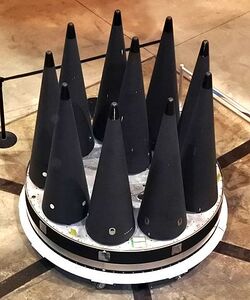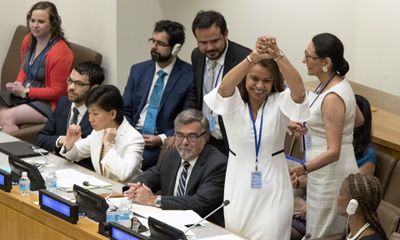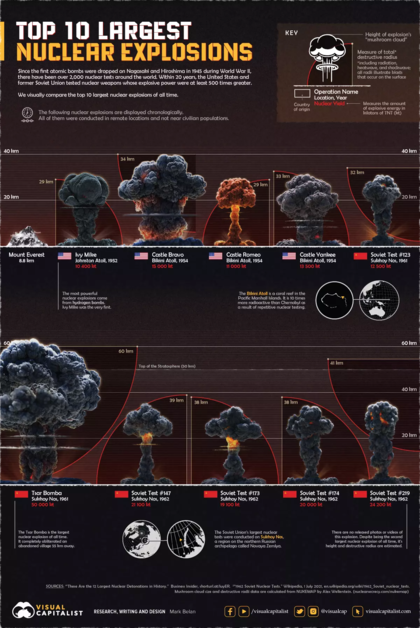Nuclear weapon
(“Weapon of mass destruction”) | |
|---|---|
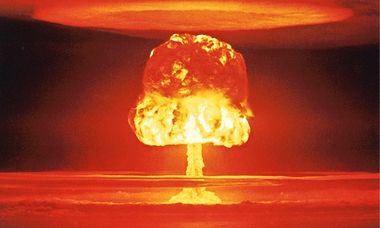 A US nuclear test over Bikini Atoll in 1954 | |
| Type | Technology |
| Interest of | • Bulletin of the Atomic Scientists • M. Elaine Bunn • Coalition for Peace Through Security • Coalition for Peace Through Strength • Henry Cooper • David Hoffman • International Institute for Strategic Studies • Bruce Kent • Manhattan Project • Jeff McCausland • Hilda Murrell • George Perkovich • UK/Atomic Energy Authority |
A nuclear weapon, in it's more powerful variants, is an explosive device that can destroy large areas, like cities. The numbers have been greatly reduced since the cold war, but enough remain to destroy live on the planet several times. The Soviet stockpile reached a peak of about 33,000 operational warheads in 1988, The U.S. stockpile reached its peak in 1966 with more than 32,000 nuclear warheads.[1]
In 2022, the International Campaign to Abolish Nuclear Weapons (ICAN) estimated that the US had reduced its nuclear weapon stockpile to 5,600 warheads.[2] Russia being at 6,257.[3] Since WW2, Black sites have been increasingly used as storage facilities.[4]
Contents
Official narrative
According to the Treaty on the Non-Proliferation of Nuclear Weapons, those nations which have these weapons of mass destruction are obliged to try to prevent their spread and to eliminate their own holdings of these weapons. A nuclear war involving USA or Russia could quite possibly result in a nuclear winter and cause humans and most other life forms to go extinct.[5]
History
Nuclear weapons were first developed by the Manhattan Project in the USA and atomic bombs were twice deployed on Japan at the end of World War II. Their creation and stockpiling was a major element in the cold war. At least 33,000 US citizens were killed by their development and mass production.[6] Many tens of thousands of other people were killed as a result of the hydrogen bomb tests carried out in remote locations such as Pacific islands.[7]
MIRV
The development and wide deployment of MIRV technology (multiple independently targetable reentry vehicle) from the 1960s onwards worsened the situation, since the possible number of detonations in a war-scenario multiplied several times along with the increase in payloads.
Strategic v. tactical
The main difference between strategic and tactical nuclear weapons (TNW) is their range.[8][9][10] TNW include gravity bombs, short-range missiles, artillery shells, land mines, depth charges, so called mini-nukes and torpedoes which are equipped with nuclear warheads.[11]
During the Cold War, such weapons were also referred to as “battlefield” nuclear weapons.[12] A war that would see the exchange of a smaller number of tactical weapons may not be considered a nuclear war in the classical sense. It is unclear whether this distinction would be meaningful in practice - or whether use of tactical weapons would lead to an escalation.[13][14][15] In 2015 General James Cartwright stated that better accuracy had made small nuclear weapons “more useable”.[16] In 2020 General Tod Wolters reported that he "is a fan of flexible first strike" as regards NATO's nuclear weapons.[17]
Non-Proliferation Treaty
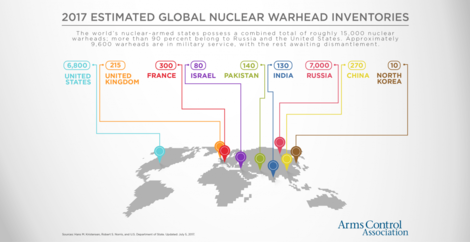
The United States conducted its first nuclear test explosion in July 1945 and dropped two atomic bombs on the cities of Hiroshima and Nagasaki in August 1945. Just four years later, the Soviet Union conducted its first nuclear test explosion. The United Kingdom (1952), France (1960), and China (1964) followed. Seeking to prevent the nuclear weapon ranks from expanding further, the United States and other like-minded states negotiated the nuclear Non-Proliferation Treaty (NPT) in 1968 and the Comprehensive Nuclear Test Ban Treaty (CTBT) in 1996.
India, Israel, and Pakistan never signed the NPT and possess nuclear arsenals. Iraq initiated a secret nuclear program under Saddam Hussein before the 1991 Persian Gulf War. North Korea announced its withdrawal from the NPT in January 2003 and has tested nuclear devices since that time. Iran and Libya have pursued secret nuclear activities in violation of the treaty’s terms, and Syria is suspected of having done the same. Still, nuclear non-proliferation successes outnumber failures and dire forecasts decades ago that the world would be home to dozens of states armed with nuclear weapons have not come to pass.
At the time the NPT was concluded, the nuclear stockpiles of both the United States and the Soviet Union/Russia numbered in the tens of thousands. Beginning in the 1970s, US and Soviet/Russian leaders negotiated a series of bilateral arms control agreements and initiatives that limited, and later helped to reduce, the size of their nuclear arsenals. Today, the United States and Russia each deploy more than 1,500 strategic warheads on several hundred bombers and missiles, and are modernising their nuclear delivery systems.
China, India, and Pakistan are all pursuing new ballistic missile, cruise missile, and sea-based nuclear delivery systems. In addition, Pakistan has lowered the threshold for nuclear weapons use by developing tactical nuclear weapons capabilities to counter perceived Indian conventional military threats. North Korea continues its nuclear pursuits in violation of its earlier denuclearisation pledges.[18]
In 2010 the Pentagon revealed that the US had 5113 nuclear weapons, down from over 31,000 in the late 1960s. More recent FOIA requests to determine the current number have been denied, notwithstanding their claim that "increasing the transparency of global nuclear stockpiles is important to non-proliferation efforts".[19]
The only nation to have acquired but then given up nuclear weapons is South Africa. The exact fate of some of South Africa's weapons is uncertain, and rumours suggest that three of them were "misplaced".[20]
Treaty banning nuclear weapons
On 7 July 2017, the Nuclear Weapon Ban Treaty was endorsed by 122 countries at United Nations headquarters in New York after months of talks in the face of strong opposition from nuclear-armed states and their allies.[21] Only the Netherlands, which took part in the discussion, despite having US nuclear weapons on its territory, voted against the treaty.
All of the countries that bear nuclear arms and many others that either come under their protection or host weapons on their soil boycotted the negotiations. The most vocal critic of the discussions, the United States, pointed to the escalation of North Korea’s nuclear and ballistic missile programme as one reason to retain its nuclear capability.[22] The United Kingdom did not attend the talks despite government claims to support multilateral disarmament.
Elayne Whyte Gómez, president of the UN Conference to Negotiate a Legally Binding Instrument to Prohibit Nuclear Weapons, Leading Towards their Total Elimination, said:
- “It’s been seven decades since the world knew the power of destruction of nuclear weapons and since day one there was a call to prohibit nuclear weapons. This is a very clear statement that the international community wants to move to a completely different security paradigm that does not include nuclear weapons.”
The 10-page treaty on the prohibition of nuclear weapons will be open for signatures from any UN Member State on 20 September 2017 during the annual UN General Assembly. While countries that possess nuclear weapons are not expected to sign up any time soon, supporters of the treaty believe it marks an important step towards a nuclear-free world by banning the weapons under international law. Beatrice Fihn at ICAN in Geneva said:
- “It’s a prohibition in line with other prohibitions on weapons of mass destruction. We banned biological weapons 45 years ago, we banned chemical weapons 25 years ago, and today we are banning nuclear weapons.” Within two years the treaty could have the 50-state ratifications that it needs to enter into international law, she said. Previous UN treaties have been effective even when key nations have failed to sign up to them. The US did not sign up to the landmines treaty, but has completely aligned its landmines policy to comply nonetheless. “These kinds of treaties have an impact that forces countries to change their behaviour. It is not going to happen fast, but it does affect them,” Fihn said. “We have seen on all other weapons that prohibition comes first, and then elimination. This is taking the first step towards elimination.”
Under the new treaty, signatory states must agree not to develop, test, manufacture or possess nuclear weapons, or threaten to use them, or allow any nuclear arms to be stationed on their territory.
Richard Moyes, managing director of Article 36, a UK organisation that works to prevent harm from nuclear and other weapons, said:
- "The negotiations had made clear that a substantial number of states think that killing hundreds and thousands of people and poisoning their environment is morally wrong and that this should be reflected in law. The UK, along with other states that possess nuclear weapons, has chosen to boycott these talks, but the process has shown that any group of committed and concerned states can and should take collective responsibility to reject these horrific weapons.”
Instead of scrapping their nuclear stocks, the UK and other nuclear powers want to strengthen the 1968 nuclear Non-Proliferation Treaty (NPT), a pact that aims to prevent the spread of the weapons outside the original five nuclear powers: the US, Russia, Britain, France and China. It requires countries to hold back from nuclear weapons programmes in exchange for a commitment from the nuclear powers to move towards nuclear disarmament and to provide access to peaceful nuclear energy technology. The new treaty reflects a frustration among non-nuclear states that the NPT has not worked as hoped.[23]
Connection to nuclear power
A proper accounting of the risks of nuclear power reveals that its development was never economically justifiable, but was primarily intended as a method of deriving radioisotopes for use in nuclear weapons - explaining a lot of the lies and other hypocrisies which continue to surround the topic.[24]
Alternative uses?
Many alternative uses have been proposed for nuclear weapons, including bizarre ones such as the disruption of hurricanes, expedite excavation, generate power, rearrange the solar system or even to attempt to plug the leaking deep water horizon oil spill. No uses have proved feasible apart from the mass extermination of living beings.[25]
Continued risk
Nuclear weapons continue to pose a real risk of human extinction.[26] Even a confrontation between smaller nuclear powers such as India and Pakistan is predicted to have the potential to cause the death of several billion people due to changes in whether patterns and the cooling effect of smoke and dust.[27][28][29] In September 2019, due to the again erupted tensions over the Kashmir region, Pakistan's Prime Minister Imran Khan discussed in an Al Jazeera interview the potential use of the arsenal of his country in a situation of military defeat.[30] A situation that would likely occur in case of a full scale war, since India at present does have supremacy with its military over Pakistan.[31]
Videos
| 5 Recently Declassified Nuclear Test Videos - Underworld 21 June 2021 |
| Nuclear weapons in modern arsenals and their catastrophic effects - CNA - 26 September 2022 |
Examples
| Page name | Description |
|---|---|
| Chevaline (missile) | |
| China/Nuclear weapons | |
| France/Nuclear weapons | |
| Iran/Nuclear weapons | |
| Israel/Nuclear Weapons | |
| Mini-nuke | A nuclear device small enough to be carried in a backpack |
| North Korea/Nuclear weapons | |
| Russia/Nuclear weapons | |
| Saudi Arabia/Nuclear Weapons | |
| South Africa/Nuclear weapons | Like the South African biological weapons program, it was developed in close cooperation with the Israeli nuclear and biological weapons programs. While officially destroyed in 1993, the bombs were in fact sold on the international black arms market, with help from the British deep state. |
| Submarine | |
| UK/Nuclear weapons | The UK has nuclear weapons on submarines |
| US/Nuclear weapons | The US had (has?) far more nuclear weapons than any other nation state and made clear a while back, that it is very willing to use them. |
| Ukraine/Nuclear weapons | Ukraine held about one third of the Soviet nuclear arsenal. |
Related Quotations
| Page | Quote | Author | Date |
|---|---|---|---|
| Bruce Cumings | “The United States is the power that introduced nuclear weapons into Korea, and it took this drastic step primarily to stabilize volatile North-South relations. Always suspicious of North Korea's intentions, in the mid-1950s the Eisenhower Administration also worried that South Korean President Syngman Rhee might reopen the war. Secretary of State John Foster Dulles wanted to restrain both sides — with nuclear weapons. Even hotheads like Rhee and Kim Il Sung, he believed, would think twice before starting a war that would rain atomic destruction on the peninsula. In January of 1958 the United States positioned 280mm nuclear cannons and "Honest John" nuclear-tipped missiles in South Korea; these were followed a year later by nuclear-tipped Matador cruise missiles. Soon American and South Korean defense strategy rested on routine plans to use nuclear weapons very early in any new war — at "H + 1," according to one former U.S. commander in Korea, meaning within one hour (more likely a few hours) of the outbreak of war if large masses of North Korean troops succeeded in attacking south of the DMZ. Annual "Team Spirit" military exercises included rehearsals for battlefield nuclear war. North Korea responded by building enormous facilities underground or in mountain redoubts, from troop and materiel depots to munitions factories and warplane hangars. This was a bit of a problem for American surveillance, in that it allowed for a great many places to hide an atomic bomb.” | Bruce Cumings | 2005 |
| John McCain | “Republican 2008 presidential hopeful John McCain crooned the words “Bomb Iran” to a Beach Boys’ tune in joking response to a question about any possible U.S. attack over Tehran’s suspected nuclear weapons program. “That old Beach Boys song, Bomb Iran ... bomb, bomb, bomb, bomb,” the Vietnam War veteran warbled softly to the band’s “Barbara Ann” when he was asked when the United States would send an “airmail message” to Iran.” | John McCain Reuters | April 2007 |
Related Documents
| Title | Type | Publication date | Author(s) | Description |
|---|---|---|---|---|
| Document:Institute for Statecraft & Center for Naval Analyses Joint Workshop | workshop summary | 22 June 2018 | Integrity Initiative | Information Warfare Study Day hosted by British Navy. Candid opinions (with a NATO-flavor) on lots of military issues. |
| Document:Jeremy Corbyn’s Chatham House speech | Article | 12 May 2017 | The Spectator | "Weapons supplied to Saudi Arabia, when the evidence of grave breaches of humanitarian law in Yemen is overwhelming, must be halted immediately." |
| Document:Labour Built the Bomb | Article | 10 July 2017 | Bill Ramsay | The prompt for this short essay is not Labour's nuclear legacy: it is what took place in the UN General Assembly last Friday when the Nuclear Weapon Ban Treaty passed into international law. |
| Document:Russia is deploying nuclear weapons in Belarus. NATO shouldn’t take the bait | Article | 24 April 2023 | Nikolai Sokov | Moscow regards the United States and Europe as parties to the war; Foreign Minister Sergey Lavrov declared that Russia and the United States are in a “hot phase” of war. These statements elevate the Russian war against Ukraine to the category of a “regional conflict” according to the 2000 and subsequent Russian Military Doctrines – a category that allows for limited use of nuclear weapons. |
| Document:Speech to the European Parliament by Beatrice Fihn, Executive Director of ICAN | Speech | 7 February 2018 | Beatrice Fihn | "Are you going to support the new Trump Nuclear Doctrine? Join the thinking of Russia, North Korea? Cheer on a new nuclear arms race? Or are you going to support the work for the prohibition and the elimination of nuclear weapons? You cannot do both." |
| Document:The Impending Dangers of Nuclear War | article | 20 February 2014 | Jim McCluskey | The risk of a catastrophic use of nuclear weapons is increasing as the nine (known) nuclear weapons states continue to upgrade their vast nuclear arsenals and keep them in a high state of readiness. |
| Document:The Kiss of Death | article | 2005 | Leuren Moret | Insight into where privatisation of the US Nuclear weapons program and military/weapons/surveillance developments are leading the world. It also provides shocking information about the extent of the apparently quite deliberate and calculated radiation contamination resulting from ever-expanding use of depleted uranium munitions. |
| Document:Will Iran Kill the Petrodollar? | article | 25 January 2012 | Marin Katusa | The possibility of Iran acquiring nuclear weapons is largely a smoke-screen used by the Western powers to obfuscate the real reasons for their escalating confrontation with Iran. |
| Document:Xi Jinping says a dark shadow looms over the world after years of peace | Article | 3 September 2017 | Tom Phillips Wang Zhen | Shen Dingli, an international relations expert from Shanghai, said Sunday’s nuclear test underlined the futility of both Washington and Beijing’s policies towards North Korea: "It's only a matter of time before Donald Trump realises he has no choice but to sit down with Kim Jong-un." |
| File:Containment of Soviet underground nuclear explosions.pdf | report | September 2001 | Vitaly V. Adushkin William Leith | |
| File:Critical Technology Assessment.pdf | Report | April 1987 | Clarence A Robinson Edwin S. Townsley | US Institute for Defense Analysis assessment of the technologies of Israel and NATO nations - including nuclear weapons capailities. Declassified in March 2015 with all but the Israeli sections remaining redacted. |
| File:DivestmentReport.pdf | report | March 2012 | Jan Willem van Gelder Petra Spaargaren Tim Wright | |
| File:ZFacts 2005 03 15 Joint Nuclear Operations.pdf | policy | 15 March 2005 |
References
- ↑ https://www.britannica.com/question/Which-country-had-the-most-nuclear-weapons
- ↑ https://web.archive.org/web/20220118070033/https://www.icanw.org/united_states
- ↑ http://web.archive.org/web/20220118070101/https://www.icanw.org/russia
- ↑ https://thebulletin.org/premium/2021-01/nuclear-notebook-united-states-nuclear-weapons-2021/
- ↑ "Symposium: The Dynamics of Possible Nuclear Extinction"
- ↑ "Irradiated – The hidden legacy of 70 years of atomic weaponry: At least 33,480 Americans dead"
- ↑ "The Secret, Silent Poisoning (Nuclear Victims in Peace and War)"
- ↑ "Big bangs from little bombs"
- ↑ http://archive.today/2021.03.14-224859/https://www.quora.com/What-is-the-difference-between-a-tactical-and-strategic-nuclear-weapon
- ↑ https://fas.org/sgp/crs/nuke/RL32572.pdf -> page 8, some problems with the definition by range of the delivery vehicle, or definition by yield of the warhead do remain
- ↑ "The Number of Times We Could Blow Up the Earth Is Once Again a Secret"
- ↑ https://www.tandfonline.com/doi/full/10.1080/00963402.2019.1654273
- ↑ https://www.zerohedge.com/geopolitical/myth-moderate-nuclear-war
- ↑ https://nationalinterest.org/blog/buzz/why-americas-b-61-12-nuclear-bomb-tempting-use-during-war-84921
- ↑ https://thebulletin.org/2017/04/mini-nukes-still-a-bad-choice-for-the-united-states/
- ↑ https://fas.org/blogs/security/2015/11/b61-12_cartwright/
- ↑ https://www.rt.com/op-ed/481959-nuclear-war-russia-nato/
- ↑ "Nuclear Weapons: Who Has What at a Glance"
- ↑ "The Pope Is Lining Up to Ban Nuclear Weapons"
- ↑ "In the 1970s and 1980s, South Africa, with help from Israel, began developing strategic nuclear weapons"
- ↑ "Treaty adopted on 7th July 2017, United Nations Conference to Negotiate a Legally Binding Instrument to Prohibit Nuclear Weapons, Leading Towards their Total Elimination"
- ↑ "North Korea claims successful test of intercontinental ballistic missile"
- ↑ "Treaty banning nuclear weapons approved at UN"
- ↑ http://www.unwelcomeguests.net/067_-_ABC%27s_of_US_Nuclear_Weapons_Program_(Underneath_6_Decades_of_Propaganda)
- ↑ "The Ten Most Bizarre Ideas For Using Nuclear Weapons"
- ↑ "Facing The Failing Culture Of Control - 2 (Atoms For Profit)"
- ↑ Nuclear Winter From an India-Pakistan War Could Kill 2 Billion saved at Archive.org saved at Archive.is
- ↑ 5 million tons of smoke created by 100 Hiroshima-size nuclear weapons saved at Archive.org saved at Archive.is
- ↑ If India and Pakistan have a 'limited' nuclear war, scientists say it could wreck Earth's climate and trigger global famine saved at Archive.org saved at Archive.is
- ↑ Pakistan Threatened India With Nuclear War And No One Noticed saved at Archive.org saved at Archive.is
- ↑ India vs. Pakistan Could Be a Nuclear War Where Billions Die saved at Archive.is
